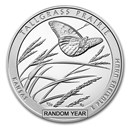IRA-Approved Silver (ATB) America the Beautiful Coins

| Quantity | Check/Wire |
|---|---|
| 1 - 9 | $210.65 |
| 10 - 19 | $207.65 |
| 20 - 99 | $203.65 |
| 100 + | $200.65 |
About America The Beautiful Coin Series
Silver America the Beautiful Coins, also known as America the Beautiful Quarters, is a series of circulating commemorative coins issued by the United States Mint. The program was authorized by the America's Beautiful National Parks Quarter Dollar Coin Act of 2008 and launched in 2010. It is part of the larger America the Beautiful Quarters Program, which honors national parks and other national sites across the United States and its territories.The America the Beautiful Coins feature unique designs on the reverse (back) side, representing different national parks, national forests, historic monuments, and other significant sites. The obverse (front) side of the coins features the familiar image of George Washington, the first President of the United States.
Each year, five different designs are released, showcasing a different national site from each state, the District of Columbia, and the five U.S. territories. In total, the program is planned to span 12 years, with a total of 56 different designs.
In addition to the circulating quarters, the United States Mint also produces America the Beautiful Coins in collector versions, such as proof and uncirculated coins. These versions are struck with greater precision and often have a higher level of detail, making them popular among coin collectors.
The silver America the Beautiful Coins series has become a unique way to celebrate and promote the diverse natural and cultural heritage of the United States. It has brought attention to various national parks and other sites of significance, encouraging people to explore and appreciate the nation's rich history and stunning landscapes.
About IRA-Approved Precious Metals
IRA approved precious metals, also known as IRA eligible metals, refer to certain types of precious metals that are allowed to be held within an Individual Retirement Account (IRA) for investment purposes. These metals are considered eligible by the Internal Revenue Service (IRS) for inclusion in self-directed IRAs, which offer individuals greater control over their retirement investments.The IRS has established specific criteria for IRA approved precious metals, which include the following metals in certain forms:
- Gold: Gold bullion coins with a purity of 99.5% or greater, such as American Gold Eagle coins and Canadian Gold Maple Leaf coins, are approved for IRAs. Additionally, gold bars or rounds that meet the same purity requirements are also eligible.
- Silver: Silver bullion coins with a purity of 99.9% or greater, such as American Silver Eagle coins and Canadian Silver Maple Leaf coins, are approved for IRAs. Silver bars or rounds meeting the same purity requirements are also eligible.
- Platinum: Platinum bullion coins with a purity of 99.95% or greater, including American Platinum Eagle coins, are eligible for IRAs. Platinum bars or rounds meeting the same purity requirements are also allowed.
- Palladium: Palladium bullion coins with a purity of 99.95% or greater, such as the Canadian Palladium Maple Leaf coin, are approved for IRAs. Palladium bars or rounds meeting the same purity requirements are also eligible.
It's important to note that not all forms of precious metals are accepted for IRAs. For example, collectible coins or numismatic coins, which carry a higher premium due to their rarity or historical value, are generally not eligible for inclusion in an IRA.
When investing in precious metals for an IRA, it's advisable to work with a custodian or trustee who specializes in self-directed IRAs and is knowledgeable about the rules and regulations surrounding IRA approved precious metals. The custodian will help facilitate the purchase, storage, and reporting requirements associated with holding precious metals in an IRA.
Investing in IRA approved precious metals can provide diversification within a retirement portfolio and act as a hedge against inflation and economic uncertainties. However, it's important to carefully consider the risks and consult with a financial advisor before making any investment decisions.















